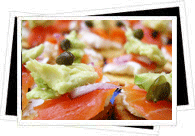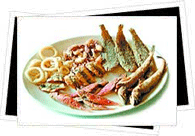
One of Spain's biggest draws comes in the form of its tasty cuisine. Characterized by fresh ingredients, mild flavors and the perfect use of seasonings, Spain's traditional food dishes come in the form of hearty family cooking. Recipes are passed down from generation to generation, and have several influences.
Spain's geography - one of the most diverse in the world - provides
the country with the freshest of everything while also creating a huge variety from region to region. With 88% of its boundaries touching water, fresh seafood is without a doubt one of the big players in Spanish gastronomy, as are fruits and vegetables from fertile farmlands, olives and olive oil hailing from groves sprawling across hills, cured meats and cheeses from the mountainous highlands.
 While Spain is practically self-sufficient in terms of its food, the country has certainly had some foreign help along the way.
The Greek and Roman civilizations which once inhabited the Iberian Peninsula, for example, contributed their love of wine and olive oil, while the Moors left behind their affinity for saffron, cinnamon, cumin, nutmeg, honey, almond confections, rice and the widespread use of fresh produce. Later, the 15th century discovery of the Americas led to the import of potatoes, sweet potatoes, tomatoes, vanilla, chocolate, zucchini, a variety of beans and much more- all of which became staples in the traditional Spanish kitchen.
While Spain is practically self-sufficient in terms of its food, the country has certainly had some foreign help along the way.
The Greek and Roman civilizations which once inhabited the Iberian Peninsula, for example, contributed their love of wine and olive oil, while the Moors left behind their affinity for saffron, cinnamon, cumin, nutmeg, honey, almond confections, rice and the widespread use of fresh produce. Later, the 15th century discovery of the Americas led to the import of potatoes, sweet potatoes, tomatoes, vanilla, chocolate, zucchini, a variety of beans and much more- all of which became staples in the traditional Spanish kitchen.
Let's not forget about Spain's infamous tapas! Essentially the fusion of bar-hopping and snacking, going out for tapas is one of the best ways to experience a wide range of Spain's traditional food at one time. Begun in Andalucía and now an international sensation, tapas can literally consist of anything from a few olives to a portion of tortilla española (Spanish potato omelette), a couple slices of ham or a serving of paella (a rice dish) and are best accompanied by wine, sherry or a cold beer.

While Spain's gastronomy is typically referred to as "Mediterranean," the geographical, cultural, weather and even historical differences throughout Spain's distinct regions result in gastronomic differences as well.
The traditional food of Andalucía boasts tons of Islamic influence, as Andalucía was the final stronghold of the Moorish empire through the Spanish Reconquest. Plus, American products like corn, peppers, tomatoes and potatoes first entered Europe through Andalucía and have been popular ever since. What to try: gazpacho (cold tomato-based soup), fried fish (pescaíto frito), egg yolk (yema) desserts, rabo de toro (bull's tail) and cured Iberian ham (jamón ibérico).
The interior of Spain, revolving around Castilla-La Mancha, Castilla-León and the Comunidad de Madrid boasts what can be defined as a countryside cuisine. The cold winters typical of this central zone of Spain have yielded traditional food dishes revolving around meats and cheeses cured in the cold mountain air and warm dishes such as hearty stews and roasted anything- lamb, suckling pig, goat, etc. What to try: cochinillo (roast suckling pig), cocido madrileño (stew of meat, cabbage, carrots & potatoes), queso manchego (cured sheep's cheese), pisto manchego (zucchini, tomatoes and eggplant in a tomato base) and migas (fried breadcrumbs).
Spain's northern coastline, which stretches across Galicia, Asturias, Cantabria and Pais Vasco, brings a wide array of traditional food dishes to the table. The Cantabrian Coast is known for Spain's best shellfish and seafood (especially in Galicia) and hearty home-cooking that focuses on seafood, dairy, meat and fresh produce.What to try: empanada gallega (pastry filled with pork, chicken, or fish), pulpo (octopus), mejillones (mussels), sardinas (sardines), bonito (tuna), bacalao (salted cod), angulas (baby eels), fabada asturiana (bean and pork stew), cidra (cider) and quesos (cheeses).
The fertile valleys running along the Pyrenees through the regions of Navarra, La Rioja and Aragón provide the area with its famous locally-grown fruits and vegetables that play heavily into the traditional food, not to mention fantastic wine! What to try: migas de pastor (bread crumbs fried with ham), vino (wine), cordero (lamb), peras (pears), melocotones (peaches).
Finally, the Mediterranean coast, along which run the regions of Cataluña, Valencia and Murcia before ending up once again in Andalucía, boasts a diverse gastronomy that incorporates lots of fresh seafood, fruits, vegetables and olive oil. Funky Barcelona is known for having Spain's most avant-garde cuisine, tying in influences from various regions of Spain along with France and Italy. Valencia's claims to fame are oranges and other fruits along with literally hundreds of rice dishes. What to try: aceitunas (olives), vino (wine), naranjas (oranges), mariscos (shellfish), paella (rice dish with saffron, vegetables and chicken, pork or shellfish).